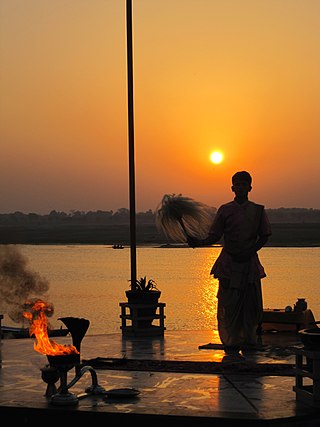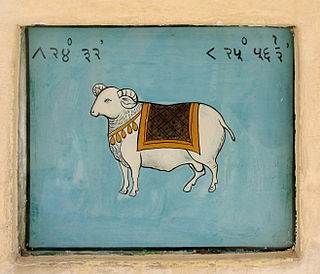Related Research Articles
The Hindu calendar, also called Panchanga, is one of various lunisolar calendars that are traditionally used in the Indian subcontinent and Southeast Asia, with further regional variations for social and Hindu religious purposes. They adopt a similar underlying concept for timekeeping based on sidereal year for solar cycle and adjustment of lunar cycles in every three years, but differ in their relative emphasis to moon cycle or the sun cycle and the names of months and when they consider the New Year to start. Of the various regional calendars, the most studied and known Hindu calendars are the Shalivahana Shaka found in the Deccan region of Southern India and the Vikram Samvat (Bikrami) found in Nepal and the North and Central regions of India – both of which emphasize the lunar cycle. Their new year starts in spring. In regions such as Tamil Nadu and Kerala, the solar cycle is emphasized and this is called the Tamil calendar and Malayalam calendar and these have origins in the second half of the 1st millennium CE. A Hindu calendar is sometimes referred to as Panchangam (पञ्चाङ्गम्), which is also known as Panjika in Eastern India.
Sankranti refers to the transmigration of the sun from one zodiac to another in Indian astronomy. In Saurmanavarsha, there are twelve Sankrantis corresponding with twelve months of a year. The Sankrantis can be broadly classified into four main categories: Ayan (Solstice), Vishuva (Equinox), Vishnupadi and Shadshitimukhi sankrantis.

Pausha, also called Paush, Poush, Pausa or Pushya, is the tenth month of the Hindu calendar, corresponding with December/January of the Gregorian calendar. In the Indian national calendar, Pausha is also the tenth month of the year, beginning on 21 December and ending on 19 January.

Magha is the eleventh month of the Hindu calendar, corresponding to January/February of the Gregorian calendar. In India's national civil calendar, Magha is also the eleventh month of the year, beginning on 20 January and ending on 18 February.
The term Uttarāyaṇa is derived from two different Sanskrit words – "uttaram" (North) and "ayanam" (movement) – thus indicating the northward movement of the Sun. In the Gregorian calendar, this pertains to the "actual movement of the sun with respect to the earth." Also known as the six month period that occurs between the winter solstice and summer solstice. According to the Indian solar calendar, it refers to the movement of the Sun through the zodiac. This difference is because the solstices continually precess at a rate of 50 arcseconds per year due to the precession of the equinoxes, i.e. this difference is the difference between the sidereal and tropical zodiacs. The Surya Siddhanta bridges this difference by juxtaposing the four solstitial and equinoctial points with four of the twelve boundaries of the rashis.
Vṛścika(वृश्चिक), also referred to as Vrishchika or Vrschika, is a month in the Indian solar calendar. It corresponds to the zodiacal sign of Scorpio, and approximately overlaps with the later half of November and first half of December in the Gregorian calendar.

The Surya Siddhanta is a Sanskrit treatise in Indian astronomy dated to 4th to 5th century, in fourteen chapters. The Surya Siddhanta describes rules to calculate the motions of various planets and the moon relative to various constellations, diameters of various planets, and calculates the orbits of various astronomical bodies. The text is known from a 15th-century CE palm-leaf manuscript, and several newer manuscripts. It was composed or revised probably c. 800 CE from an earlier text also called the Surya Siddhanta. The Surya Siddhanta text is composed of verses made up of two lines, each broken into two halves, or pãds, of eight syllables each.

Saura is a term which refers to the solar days and months in Vedic era and medieval Indian calendars, to differentiate them from lunar system in the lunisolar calendars.
Samvatsara (संवत्सर) is a Sanskrit term for a "year" in Vedic literature such as the Rigveda and other ancient texts. In the medieval era literature, a samvatsara refers to the "Jovian year", that is a year based on the relative position of the planet Jupiter, while the solar year is called varsha. A jovian year is not equal to a solar year based on the relative position of Earth and Sun.
Karkaṭa, also referred to as Karka or Karkatha, is a month in the Indian solar calendar. It corresponds to the zodiacal sign of Cancer, and overlaps approximately with the later half of July and early half of August in the Gregorian calendar.

Meṣa, or Mesha (मेष), is a month in the Indian solar calendar. It corresponds to the zodiacal sign of Aries, and overlaps with about the second half of April and about the first half of May in the Gregorian calendar. Generally Mesha month starts on 13th or 14th of April, called as Mesha Sankranti.

Vṛṣabha, or Vrishabha, is a month in the Indian solar calendar. It corresponds to the zodiacal sign of Taurus, and overlaps with about the second half of May and about the first half of June in the Gregorian calendar. The first day of the month is called Vrishbha Sankranti, and it generally falls on May 14 or 15.
Siṃha is one of the twelve months in the Indian solar calendar.
Kanyā is one of the twelve months in the Indian solar calendar.
Tulā is one of the twelve months in the Indian solar calendar.
Mīna, or Meena, is a month in the Indian solar calendar. It corresponds to the zodiacal sign of Pisces, and overlaps with about the later half of March and about the early half of April in the Gregorian calendar. First day of the Meena month, called as Meena Sankranti generally falls on March 14.

Mesha Sankranti refers to the first day of the solar cycle year, that is the solar New Year in the Hindu luni-solar calendar. The Hindu calendar also has a lunar new year, which is religiously more significant. The solar cycle year is significant in Assamese, Odia, Punjabi, Malayalam, Tamil, and Bengali calendars.
Mithuna is a month in the Indian solar calendar. It corresponds to the zodiacal sign of Gemini, and overlaps with about the second half of June and about the first half of July in the Gregorian calendar.
Dhanu, Dhanus or Dhanurmas (धनुर्मास) is a month in the Hindu calendar, Malayalam calendar and others. It corresponds to the zodiacal sign of Sagittarius, and overlaps with approximately the second half of December and about the first half of January in the Gregorian calendar.
Kumbha is a month in the Indian solar calendar. It corresponds to the zodiacal sign of Aquarius, and overlaps with about the second half of January and about the first half of February in the Gregorian calendar.
References
- 1 2 3 James G. Lochtefeld (2002). The Illustrated Encyclopedia of Hinduism: A-M, N-Z (Vol 1 & 2). The Rosen Publishing Group. pp. 682–683. ISBN 978-0-8239-3179-8.
- 1 2 Robert Sewell; Śaṅkara Bālakr̥shṇa Dīkshita (1896). The Indian Calendar. S. Sonnenschein & Company. pp. 5–11, 23–29.
- ↑ Nachum Dershowitz; Edward M. Reingold (2008). Calendrical Calculations. Cambridge University Press. pp. 123–128. ISBN 978-0-521-88540-9.
- ↑ Christopher John Fuller (2004). The Camphor Flame: Popular Hinduism and Society in India. Princeton University Press. pp. 291–293. ISBN 978-0-69112-04-85.
- 1 2 3 Robert Sewell; Śaṅkara Bālakr̥shṇa Dīkshita (1896). The Indian Calendar. S. Sonnenschein & Company. pp. 10–11.
- ↑ James G. Lochtefeld (2002). The Illustrated Encyclopedia of Hinduism: A-M, N-Z (Vol 1 & 2) . The Rosen Publishing Group. p. 411. ISBN 978-0-8239-3179-8.
- ↑ Bangalore V. Raman (2003). Studies in Jaimini Astrology. Motilal Banarsidass. pp. 10–19. ISBN 978-81-208-1397-7.